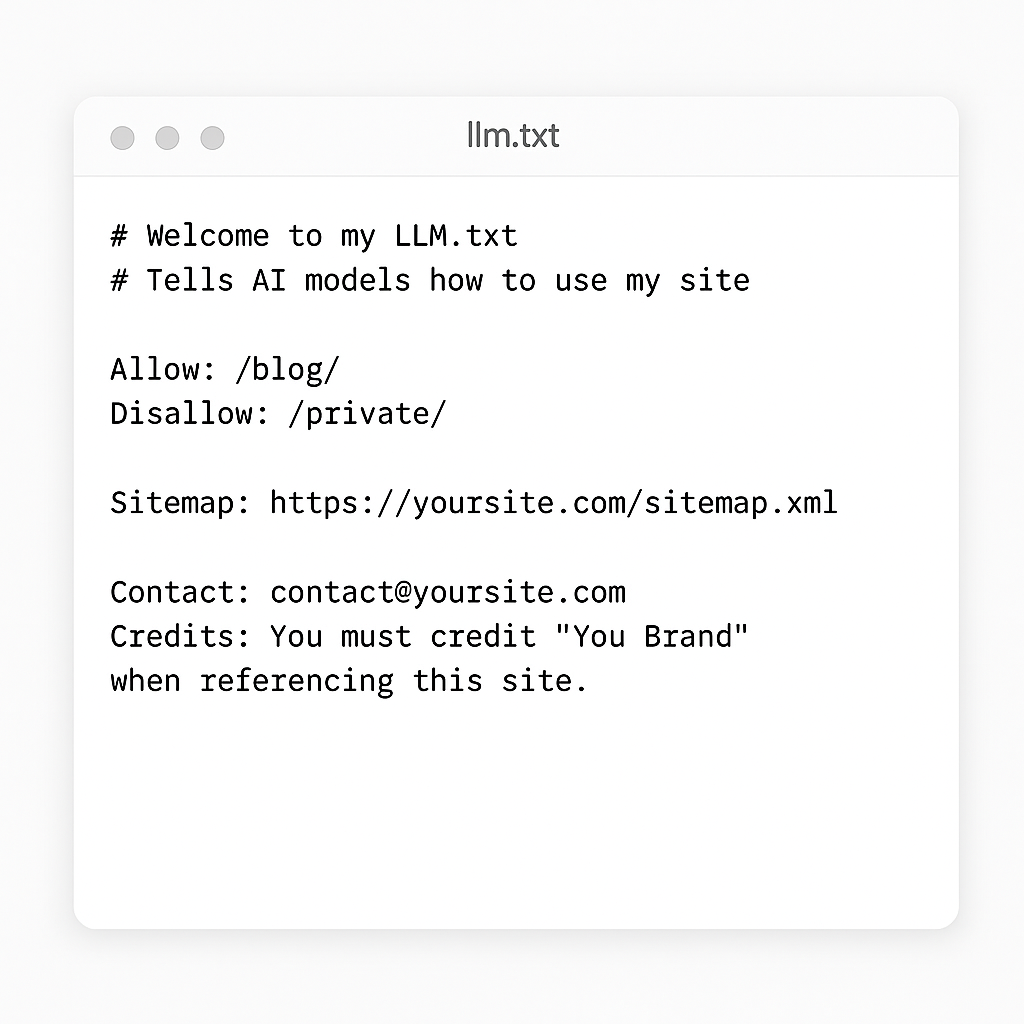Last Updated on August 21, 2025 by Becky Halls
With all the new advice around AI search and rankings, you’ve probably heard to term ‘LLM.txt’ crop up a couple of times by now, but what is LLM.txt and how can it help your brand? We like to think of it in a fun social way: If robots.txt was the original bouncer at your SEO club, LLM.txt is the new VIP list manager for AI search.
In 2025, search isn’t just “blue links on Google.” It’s AI answers pulled from across the web – snippets that talk back, summarize your content, and serve it up inside tools like ChatGPT, Claude, and Gemini.
The problem is, without guidance, AI can chew on your content however it likes. That’s where LLM.txt steps in.
It’s your chance to:
-
Control what AI models see (and don’t).
-
Request credit or attribution back to your brand – super important if you want all important backlinks!
-
Signal authority in the age of generative search.
So let’s break down exactly what LLM.txt is, why it matters, and how to add it to your site today.
What is LLM.txt?
LLM.txt is a plain text file that lives in your site’s root directory (just like robots.txt). Instead of instructing web crawlers, it speaks directly to Large Language Models (LLMs).
Here’s what it can do:
-
✅ Allow / Disallow directories or pages for AI access.
-
🗺️ Point to your sitemap for structured crawling.
-
✍️ Request credit/attribution when your content is used.
-
📩 Provide contact info in case AI providers want permissions.
In short: LLM.txt is like a polite letter taped to your digital front door saying:
“Hey AI bots, welcome! Here’s what you can use, here’s what’s off-limits, and if you quote us, please remember the name.”
Why Does LLM.txt Matter?
1. AI Search Is Eating Traditional Search
By 2025, 70% of marketers expect AI-driven search engines to become the primary way users discover content (BrightEdge). That means your blog post isn’t just competing with other blogs – it’s competing with LLMs spitting out direct answers.
2. Attribution Is at Stake
Right now, AI is notorious for summarizing without credit. But LLM.txt introduces a new lever: you can request credits or at least make your brand’s presence known.
3. Control = Trust
Just like robots.txt helped webmasters control Googlebot, LLM.txt signals authority. Having one in place says: “We’re serious about how our content is handled.”
How to Create an LLM.txt File
The beauty of LLM.txt? It’s simple. No plugins, no code libraries. Just a text file with rules. Let us show you how!
Step 1: Open a Text Editor
Notepad, VS Code, TextEdit – pick your flavor. Save as:
Step 2: Add Your Rules
Here’s a practical example:

Step 3: Upload to Root Directory
Place the file in the same spot as your robots.txt.
So if your site is:
Your LLM.txt should live here:
Step 4: Test It
Visit the URL in your browser. If the text displays, congrats, you’re officially LLM-ready!!
How LLM.txt Works with SEO
Think of it like this:
-
Robots.txt tells crawlers how to index.
-
Sitemap.xml shows crawlers what’s important.
-
LLM.txt tells AI how to reuse and attribute.
Together, they form your AI + SEO control stack.
Best Practices for LLM.txt
-
Be Specific
Don’t just drop “Allow: /.” Guide AI towards your best, most evergreen content. -
Update Regularly
As you create new sections (guides, docs, blogs), update your LLM.txt. -
Request Credit Clearly
Use the “Credits” line to spell out how you want attribution. Even if not all models honor it today, future-proofing is smart. -
Use Contact Info
If an AI company wants to license your content, make it easy.
Advanced Use Cases
-
E-commerce: Point AI to product pages, block /checkout/.
-
SaaS: Allow blogs & docs, block internal dashboards.
-
Agencies: Show off case studies, hide client-only reports.
Basically: curate your content like a menu. Show off the signature dishes, keep the messy kitchen behind the curtain.
Why Smart Brands Are Jumping on LLM.txt
-
Early movers = authority. Being one of the first sites with LLM.txt puts you ahead in trust signals.
-
Backlink potential. If AI tools respect your credit line, you could see referral traffic.
-
Crisis prevention. Avoid having sensitive/private areas hoovered into AI training sets.
“Just like schema markup seemed “optional” a decade ago (and is now essential) LLM.txt will become a must-have signal for AI SEO.” Becky Halls at 3Way Social
FAQ: LLM.txt Explained
Q: What is LLM.txt, really?
A: It’s a plain text file that guides AI models on what content they can use, what to skip, and how to credit you.
Q: Does every site need one?
A: If you want visibility in AI search, yes. Even a simple version is better than nothing.
Q: Can I block AI entirely?
A: Yes—Disallow: / will do it. But you’ll vanish from AI answers, which may hurt long-term visibility.
Q: Is crediting guaranteed?
A: Not today. But some AI providers have already hinted they’ll respect it. The more voices requesting credit, the more likely it becomes a standard.
Q: Where should I put it?
A: In your site’s root directory: https://yoursite.com/llm.txt.
Q: How often should I update it?
A: Anytime your content structure changes or you launch a new section.
Final Word
LLM.txt might look tiny, but its impact is massive. It’s the bridge between your content and the AI models shaping tomorrow’s search results.
Add it today, and you’re not just future-proofing—you’re planting your flag in the AI search landscape.
Because here’s the hard truth:
Being invisible to humans is bad.
Being invisible to AI? Fatal.
So write it, upload it, and let your LLM.txt do the talking.





